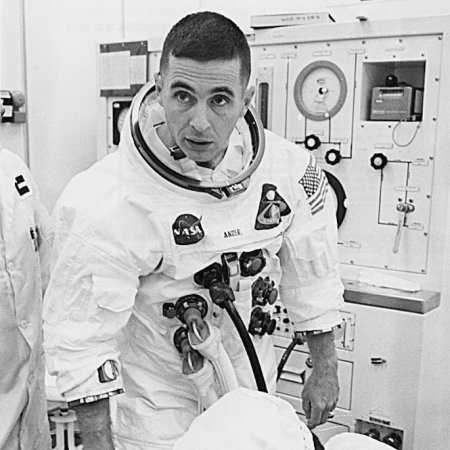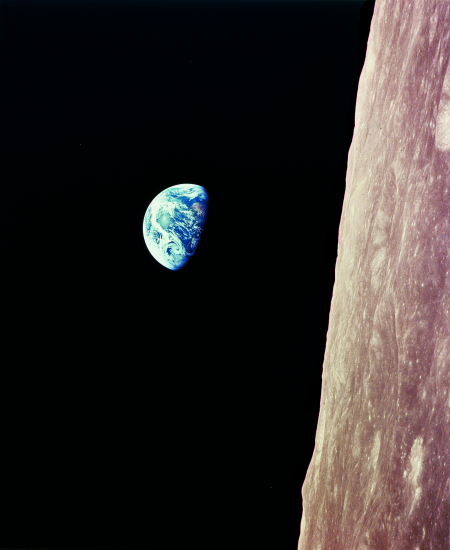Bill Anders, the thoughtful astronaut who liked to go fast

Bill Anders suiting up for the December 1968
launch of Apollo 8
The death of Apollo 8 astronaut Bill Anders on June 7, 2024 requires that I give the public my own personal taste of the man, whom I met and interviewed when I was writing my 1998 history of the Apollo 8 mission to the Moon, Genesis: the Story of Apollo 8.
The first time I met Bill Anders was in 1997. Anders had told me to fly into Los Angeles for our first interview. A few days before my arrival, however, his wife Valerie realized that both she and Anders would not be in Los Angeles, but in San Diego.
Rather than have me change flights, Anders agreed to drive up to LA, pick me up at the airport, and drive me to San Diego so I could interview Valerie. During the two hour drive I would be able to interview him.
Anders was waiting for me as I exited the terminal. As I have noticed routinely, he seemed much smaller than I expected, as does every astronaut at first meeting. Anders guided me to a low-slung sports car, which he slid into with ease. I — being 6′ 4″ — had to crowbar my way in.
And then Anders demonstrated instantly one reason he was chosen to fly to the Moon. He started the car, and backed out of the parking space and out of the lot at what seemed to me to be about seventy miles an hour. And he did it with total control.
For you see, the one thing Anders liked above all was going fast. During our conversation during that drive, he made sure I understood that as far as he knew, the Apollo 8 capsule still held the fastest human speed record, its return speed of more than 25,000 miles per hour as it hit the Earth’s atmosphere being the fastest of any Apollo mission.
His death on June 7, 2024 at the age of 90 only confirmed that love of flight and speed. After his retirement he spent much of his time flying antique plans in competitive races. On June 7, 2024 he was apparently doing some aerobatic maneuvers in a Beechcraft T-34 — used for years by NASA and others as a trainer for pilots — when he appeared to misjudge his altitude when he started one maneuver, hitting the water at the bottom of a large loop.
The accident was a great tragedy, but for Anders he at least went out doing something he loved more than anything.
But Bill Anders was much more than a speed demon. He was also one of the more thoughtful and philosophical astronauts I have ever met. While his fellow crewmembers of Apollo 8 — Frank Borman and Jim Lovell — both considered religion important in their lives, they took it for what it was, accepted it, and simply practiced it. The flight around the Moon changed nothing. As Lovell told me, “Going to the Moon to me was not a religious event.”
To him, if you believed in God you could find him anywhere, either on Earth or in a tiny capsule floating in the darkness of space. Two hundred and forty thousand miles was “just a drop in the bucket” for an entity that had created the entire universe [Genesis, page 253]
For Anders however the flight of Apollo 8 radically changed his outlook on religion and life. Prior to Apollo 8 he was a devout Catholic. After Apollo 8 he abandoned that religion, spurred by what his thoughtful mind experienced while circling the Moon.
The vast emptiness of space made the Catholic rituals he had obeyed faithfully since childhood seem insufficient to him “We’re like ants on a log.” he explained. “how could any earth-centered religion ritual know what’s God’s truth is?” [Genesis, page 253]
That he ceased participating in any religion after Apollo 8 did not mean he stopped believing in God. He just decided there was no way for any human being to really understand that God. Instead, we must try our best to live good lives, and let the chips fall where they may.
Anders thoughtfulness was further illustrated by his most famous achievement, his color picture of Earthrise. Borman took a black and white picture just before Anders, framing the picture without thinking with the horizon on the bottom, as any Earth-bound person would. (I know this because this is how Borman framed a print of this picture in his office in 1997.)

After they changed to color film, Anders however did not see it that way. Instead, he saw himself and the Apollo capsule as just one more object in the solar system, all orbiting either the Moon or the Earth or the Sun along the ecliptic. Thus, he didn’t perceive the Earth rising from behind a horizontal horizon line, but appearing instead sideways from behind a vertical lunar sphere. Apollo 8 was circling the waist of the Moon, as was the Moon around the Earth, and the Earth around the Sun.
Thus the correct way to frame Anders’ photograph is to the right. This is also how he had it framed in his own home in 1997, something I discovered when he and I arrived there after that long two hour drive.
For Anders, his journey to the Moon had not simply been an adventure in fast flying. He couldn’t help think about its greater implications, and this had caused him to thoughtfully transend from an Earth-bound person to possibly the first person in human history to see himself truly as a spaceman, in space flying among the planets.
R.I.P. Bill Anders. You along with everyone else involved in that first mission to another world left behind a testament to the future that many endless generations of future space-farers will never forget.
On Christmas Eve 1968 three Americans became the first humans to visit another world. What they did to celebrate was unexpected and profound, and will be remembered throughout all human history. Genesis: the Story of Apollo 8, Robert Zimmerman's classic history of humanity's first journey to another world, tells that story, and it is now available as both an ebook and an audiobook, both with a foreword by Valerie Anders and a new introduction by Robert Zimmerman.
The print edition can be purchased at Amazon or from any other book seller. If you want an autographed copy the price is $60 for the hardback and $45 for the paperback, plus $8 shipping for each. Go here for purchasing details. The ebook is available everywhere for $5.99 (before discount) at amazon, or direct from my ebook publisher, ebookit. If you buy it from ebookit you don't support the big tech companies and the author gets a bigger cut much sooner.
The audiobook is also available at all these vendors, and is also free with a 30-day trial membership to Audible.
"Not simply about one mission, [Genesis] is also the history of America's quest for the moon... Zimmerman has done a masterful job of tying disparate events together into a solid account of one of America's greatest human triumphs."--San Antonio Express-News


I think he died on June 7th, not January 7th
(feel free to delete this comment when you’ve fixed the post)
Marshall: Thank you. Stupid fingers. They don’t do what my mind wants. Now fixed.
“how could any earth-centered religion ritual know what’s God’s truth is?” What sadness that he didn’t have a better understanding of Christian theology. Ritual and rite is not the source of Truth, God is through His Word. I guess many may confuse rites, rituals, and traditional practice with actual theology but to do so is simply that: confusion.
The fundamental level of Christian theology is certainly not “earth-centered” but encompasses all of creation. I’m not sure how Mr. Anders would expect God to share Himself with his creation outside of the realm of experience and existence of those with whom He was sharing. It follows that while God’s Truth is present at all places and all times, it would be understood through the lens of locality and experience of every being created.
Robert Pratt: Christian theology is not the same as Catholic ritual and rites. There is a difference, and it is the latter that Anders suddenly saw as trivial. Note too that this distinction was one of many factors that drove the Reformation, which largely abandoned those rites and rituals to focus more on the the actual words of the Bible.
Rest In Peace, Mr. Anders.
And Mr. Zimmerman, keep up the good work.
I enjoyed getting to know more about Anders and his fellow astronauts in reading the excellent Genesis: the Story of Apollo 8. These were some very brave men, being the first to travel any real distance from the safety of Earth. After watching some of the Apollo missions as a child, I find it disheartening that so many of these early explorers have passed away without getting to see humans return to the moon.
Regarding Anders’ fatal accident, I think I’d rather die doing something I hate than something I love. At least I’d get out of doing some of it. ;-)
I’ve had his photo of the Earth and Moon framed and hanging on my wall for several years now. A couple of years ago, after hearing how Bill Anders framed it, I reoriented it, and now display it properly.
God rest his soul.
I think I’d rather die doing something I hate than something I love. At least I’d get out of doing some of it. ;-)
I’ve never thought of it that way, but I don’t disagree.
I believe this is where I first learned that the photo is normally shown “sideways” from how it was taken.
RIP Bill Anders.
Sad that Anders is gone, but 90 was a ripe old age and he went out with a bang.
The most revealing part of this story is that Bob, who has previously talked of his caving avocation, stands 6-4. That hobby would seem to be more appealing to those smaller guys and gals.
Concerned: Being tall in cave exploration has both advantages and disadvantages. The advantages is a long reach and step, allowing you to reach things with your arms and legs that a short person can’t.
The disadvantage in small spaces is obvious, but I have always been relatively thin. The bigger obstacle is mental. Even a small person can get spooked if the passage is really small.
Bob: I thought of you and caving because I recently visited Cumberland Caverns in TN and saw one of the largest cave volumes in the country (they’ve actually held concerts down there). Our guide told the story of the discoverer/explorer over 100 years ago who had to slither through passages the width of a large dinner plate to find some of the unbelievable spaces. She also told of the time all his lights went out (they turned out the lights to illustrate–talk about behind the black, LOL) and he thought he was a goner for several days. Conversations with God allowed him to regain his wits and feel his way out. That was a small but powerful demonstration of the mental challenge involved.
Nicely done in 2017
Visit with Bill Anders at the Heritage Flight Museum
KOMO News
https://youtu.be/YJ0xo1NcHK0
(5:11)